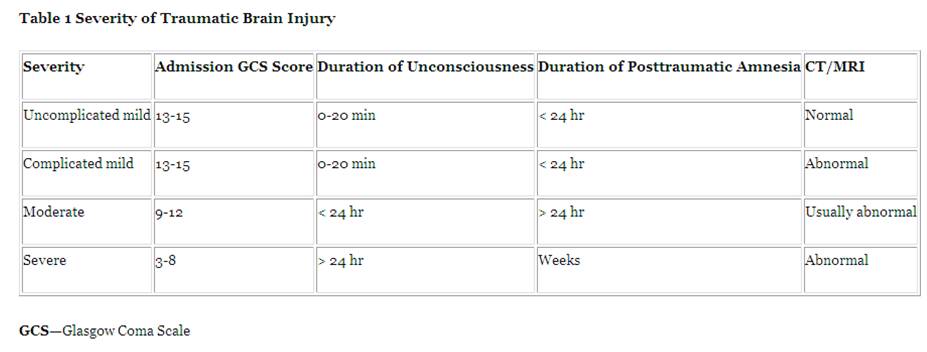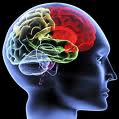Estimates from the Center for Disease Control (CDC) are that more than 1.7 million people sustain a traumatic brain injury (TBI) each year in the United States [Faul M,2010 #1]. These data are based on those individuals seeking medical care at emergency departments (EDs): of these 52,000 die, 275,000 are hospitalized, nearly 80%, ~1.4 million, are treated and released.
TBI runs the gamut from mild (mTBI/concussion) to severe, the latter contributing to a third of all injury-related deaths in the US. In fact, TBI is the leading cause of death and disability in young American adults. However far greater numbers with mTBI/concussion do not go to EDs and often are unaware they have sustained a concussion; three-fourths of all TBIs are, in fact, this mild form. Although the exact number is unknown, the CDC estimates that between 1.6 and 3.8 million concussions occur in sports and recreational activities annually. Age is an important factor: young children (0 to 4 years), teens (15 to 19), and older adults are most likely to sustain a TBI; in fact, those older than 75 have highest rates of TBI-related hospitalization and death [Faul M, 2010 #1].
From these numbers, it is clear that TBI is a leading cause of injury death and disability in the US and the annual direct medical costs and indirect costs including lost productivity from TBI was estimated at $76.5 billion more than a decade ago [Langlois, 2006, 375-8]. Currently, head trauma and concussions among high school football to NFL players, along with other contact sports and warfare injuries [DeKosky, 2010, 1293-6], have recently received much attention [Schwartz, 2012 #547].
The CDC data however do not consider battlefield TBIs, often the result of exposure to improvised explosive devices (IEDs), “a regular event for troops traveling the roads in Iraq and Afghanistan” (NY Times, March 17, 2012, Kate Wenner).
Concussion is of major concern since 170 million US adults participate in sports and other physical activities, while 38 million children and adolescents join in organized sports [Daneshvar, 2011, 1-17]. Apprehension is both with sudden death, the “two-hit syndrome,” and with the sequelae of mild TBI occurring years later (dementia pugilistica (DP), “punch-drunk syndrome,” and chronic traumatic brain injury (CTBI) more recently termed chronic traumatic encephalopathy (CTE) [McKee, 2009, 709-35]) resulting from repeated concussions.
Neuropathologically all these conditions are comprised of intraneuronal neurofibrillary tangles (NFTs), as well as extracellular NFTs, with abnormal deposition of microtubule-associated tau protein [McKee, 2009, 709-35;Forstl, 2010, 835-9;DeKosky, 2010, 1293-6;Saing, 2011 #58], TAR DNA binding protein 43 (TDP-43) pathologic changes but with little amyloid Aβ pathology.
Clinically, all present as a slowly progressive tauopathy [McKee, 2009, 709-35]. Consequently, for both accurate diagnosis and rationale therapy aimed at preventing such sequelae, elucidation of TBI pathophysiology is an important challenge for both physicians who care for TBI patients and neuroscientists who study the central nervous system’s (CNS) response to injury. Equally important are prevention and a better scientific understanding of the recovery process, intervention and rehabilitation.
We now view TBI as a multidimensional, dynamic process. As a clinical example of this there are numerous instances of TBI patients who are initially stable, lucid and “intact” who then rapidly deteriorate. This pattern is accounted for by delayed hematoma (epidural or subdural) or expanding contusions that can be cured by interventional neurosurgery (one notable case is Natasha Richardson, who died while skiing in March 2009 after suffering what initially appeared to be a fairly mild head trauma). Others relate to uncontrolled brain edema and release of excitotoxic molecules such as glutamate (see below) that may not respond to conventional management. The secondary cellular injury, known for a century in response to the passive, primary, traumatic injury is a major contributor to brain swelling and tissue loss after TBI. The penultimate neuropathologic picture evolves over the first few hours and days after primary injury, while the physiologic, clinical, and behavioral aspects of recovery can continue for years.
In fact, neuropathologic changes such as neuroinflammation and cell death may also continue for years. Consequently, therapy should be instituted with appreciation of such multidimensional TBI neuropathology and how it evolves.
Etiology (causes): Brain injury may be caused by any of several types of head trauma, including the more typical closed head injury (CHI), with rapid acceleration/deceleration resulting in the brain strike the hard inner table of the skull; direct impact to the head; penetration by a missile or other foreign object; or, more recently shock-waves to the head or so-called “blast” TBI. Despite minor differences in their pathology, the acute and mid-term management are similar in most cases. However, with mild TBI (concussion), especially repetitive concussion, long-term management, and especially prevention of sequelae, may be changing.
Pathogenesis (evolution): The pathologic changes of the primary injury of TBI results in explosive, necrotic cell death of all brain tissue cells, with invasion of blood components, both cellular and humoral, into the brain. The secondary injury then begins immediately, and results from a relatively uncontrolled “vicious circle” of biochemical and physiologic events in response to the trauma. The biochemical events include flooding of arachidonic acid metabolites (e.g., prostaglandins); various proteases including kinins and cytokines; oxygen free radicals (reactive oxygen species, ROS) and lipid peroxidation; changes in electrolytes (e.g., calcium and magnesium); excitotoxic neurotransmitters (such as glutamate) and other response molecules.
Many of these reactions are included in the brain’s innate immune response to trauma but, themselves, can result in progressive injury to otherwise intact brain tissue. Important here are changes in the cerebral neurovascular unit (NVU) and blood brain barrier (BBB), changing vascular reactivity furthering ischemic injury, brain swelling (hyperemia, edema, or both), additionally damaging neurons, astrocytes, oligodendrocytes and microglia (now by apoptotic, rather than initial, necrotic cell death), and by activating macrophages and resident microglial inflammatory responses that further damage neurons and glial cells. The patient with moderate or severe TBI may also have systemic abnormalities such as altered cardiopulmonary status, coagulation defects, levels of circulating catecholamines, and nutritional changes that may impact treatment approaches. These systemic responses are similar to those that accompany sepsis, but in a sterile environment, known as systemic inflammatory response syndrome (SIRS). It is possible, although data is not so evident, that similar, but less intense SIRS also accompanies mild TBI/concussion. For those TBI Victims who enter an ED, the following table of severity is informative. However, for mild TBI and concussion sufferers, such information is not readily available.
 (from http://what-when-how.com/acp-medicine/traumatic-brain-injury-part-1/)
(from http://what-when-how.com/acp-medicine/traumatic-brain-injury-part-1/)
Management of TBI in General
A useful approach to TBI management is found here.
No reliable evidence currently can predict which individual suffering from mTBI will develop neurodegenerative sequelae such as Alzheimer’s, (AD), Parkinson’s (PD), amyotrophic lateral sclerosis (ALS, Lou Gehrig’s disease) or chronic traumatic encephalopathy (CTE) years later. However, it is extremely likely that such development will occur in those mTBI sufferers that acquire post-concussion syndrome (PCS) which includes symptoms such as headache, dizziness, fatigue, and clinical deficits in cognition, any of which can be seen even after mild injuries without loss of consciousness. Although the short- and midterm prognosis for recovery is good: most cognitive and somatic sequelae improving markedly by three months; 85% of patients experience no disabling symptoms one year after injury. In that percentage of patients who have post-concussive complaints and disability over periods exceeding one year, psychogenic factors can often contribute to the persistence of symptoms. Patients who have persistent symptoms of anxiety, depression, or who need both appropriate diagnosis and treatment, should preferably be evaluated by a psychiatrist who has experience with TBI.
